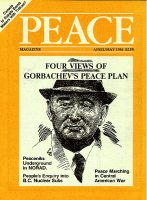
Peace Magazine Apr-May 1986, page 19. Some rights reserved.
Search for other articles by Shirley Farlinger here
Ruth Leger Sivard, World Military and Social Expenditures, U.S. $8.00 . Order from World Priorities Inc, Box 25140, Washington DC 20007 or from Project Ploughshares, Conrad Grebel College, Waterloo, Ontario.
Ruth Leger Sivard's 1985 edition of World Military and Social Expenditures has a black cover. Black is appropriate.
The Tenth Anniversary Edition of this bible of the peace movement tries to strike a balance between hope and despair, but the figures make the task difficult.
"The ultimate absurdity," the survey states, "is the 34 trillion dollars spent since World War II to create a nuclear arsenal which, if used, will mean global suicide." The megatonnage is enough to kill every person now living twelve times. Contrary to the hope of bringing democracy to the world, the number of countries ruled by military governments has grown from 22 to 57.
Sivard begins by reminding us of the origin of the Charter of the United Nations. Millions of people around the world helped write the draft proposals. In the U.S. alone almost two million copies of the draft were circulated.
Forty years later the world's people appear to have lost control of the decision-making political process. A less equitable, less secure world and growing violence are the "realities of 1985," Sivard notes. One adult in three cannot read and write, one in four is hungry.
Each page is illustrated with maps, charts, and graphs as Sivard searches for the best way to get the message across. Some graphs are confusing and take time to understand. The familiar dot graph representing nuclear explosive power with dots has been redone with a huge blood-red splotch representing the 16,000 megatons of today's nuclear arsenal. Below are the tiny drops of World War II, Korea, and Vietnam wars which killed 39 million with 10.9 megatons.
A section on the interaction of Atoms for Peace and Atoms for War lists the world's nuclear reactors and the plutonium produced. "In 1984 enough plutonium was separated from spent fuel to make 7,500 one-kiloton nuclear bombs."
Ten of the 52 pages are lists comparing expenditures of all countries in terms of military, education, health, nutrition, safe water, and Gross National Product for 1982. This yields an Economic Social Standing based on an average of ranks for GNP per capita, education and health, which Sivard explains is only to convey a general impression of relative standing. In this comparison Canada is seventh, the U.S. fourth and the USSR ranks 26th of 142 countries. Chad is 142nd, with a life expectancy of 42 and only 26 percent of the population with safe water. Canadian water is given as 100 percent safe, life expectancy as 74 years and our literacy as 99 percent.
Sivard pioneered the juxtaposing of military and social expenditures. Now aged 70, Sivard recalls how it all began. "In 1%8 I headed the economics staff of the Arms Control and Disarmament Agency," she says, "and began to work on world estimates in my job. Social comparisons were added to military expenditure estimates but by 1973 the government no longer wanted these included. I felt this publication was the most important thing the agency did, so I continued it on my own. I rely on specialists for information, part-time help, and Pentagon sources. It gets a great response from around the globe and there are now ten foreign language editions." The 25,000 annual printing is always sold out. Her biggest customers are American universities, who get a special price. Without that her budget would break even; the difference is made up from grants and donations.
In a visionary leap in the new edition, Sivard dreams that the two superpowers reject Star Wars, lowering the military threat and use the two trillion dollars saved over ten years to create jobs ($18 billion), increase health services ($20 billion), provide safe water for all ($20 billion). Together the U.S. and the USSR announce that $100 billion a year will be made available to an international planning board, she posits. This is a dream to work toward!
On the last page Sivard notes the failure of technology, giving alternate examples of U.S. and USSR military malfunctions. Prophetically, she ends with the failure of the cruise missile to operate properly on snow-covered terrain. This was before the Cold Lake and Beaufort Sea crashes.
Ernie Regehr, Research Director of Project Ploughshares, says of the publication, "Its value is in the general picture and the detailed description of Sivard's sources." You don't have to be a researcher to make use of this resource.

Peace Magazine Apr-May 1986, page 19. Some rights reserved.
Search for other articles by Shirley Farlinger here